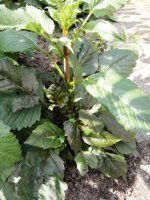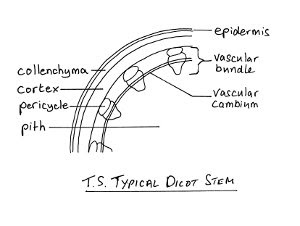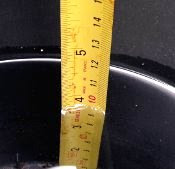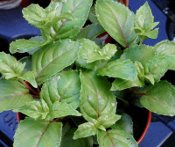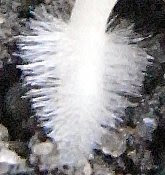
Water enters plant roots (along a concentration gradient) through fine root hairs (see '
Apoplast And Symplast Pathways In Root A Hair') then makes its way across the root tissues (cortex, endodermis and pericycle (see '
Cross Section Of Young Dicot Root') towards the xylem, that part of the vascular system which distributes water and dissolved mineral salts throughout the plant.
THREE ROUTES OF TRAVEL
Water may travel across the root by one of three pathways:
- apoplast - within cell walls only (unselective)
- symplast - in cytoplasm, through plasmodesmata (selective)
- cell-to-cell (transmembrane pathway) - through vacuoles of each cell (selective)

We have seen that a
typical cell comprises an outer cell wall surrounding a partly permeable plasma membrane, enclosing cytoplasm and inner vacuole. We have also seen that the cytoplasm of adjacent cells is connected through 'gaps' in the cell wall called plasmodesmata.
APOPLAST PATHWAY
If once water enters the root hair, it travels from cell to cell, across the cortex, in the CELL WALLS ONLY, it is said to take the 'APOPLAST' pathway. Because cellulose is pervious and non-selective, both water and ALL dissolved minerals may be carried this way. Note that the plasma membrane (separates cell wall from cytoplasm) need not be crossed, not until the endodermis - a defensive ring of cells, one cell deep - is reached. So OSMOSIS need not be involved up to this point, only diffusion.
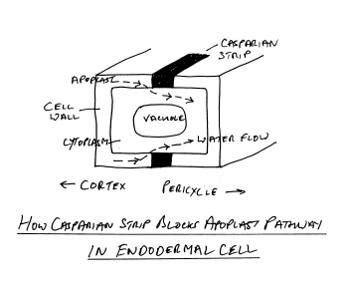

At this point, the impervious Casparian strip blocks progress and forces both the water and mineral salts to cross the plasma membrane into the cytoplasm, where they can continue on the symplast pathway. However, not all mineral salts make it - the plasma membrane is selective and can filter out unwanted solutes.
SYMPLAST PATHWAY
If water passes from the cell wall through the plasma membrane to the cytoplasm, it can then travel from cell to cell through the plasmodesmata in the cell walls. This is called the 'SYMPLAST' pathway. Note that the plasma membrane, because it is partly permeable, can only be crossed passively by OSMOSIS. Passage of dissolved nutrients, because their molecules are too large, are blocked and cannot pass passively; they must cross the plasma membrane into the cytoplasm by active transport, a selective process; osmosis is not involved.
CELL TO CELL
Water can also enter the vacuoles (which are within the cytoplasm), then pass from vacuole to vacuole. This is called the 'CELL TO CELL' or 'TRANS MEMBRANE' pathway.
POINT OF INTEREST
It is commonly supposed that both water and minerals enter the plant cytoplasm as one process. They don't. Each enters independantly of the other; mineral salts can enter a plant even when no water is being absorbed. However, once inside the cytoplasm, minerals travel in solution.
TOXIC VEGETABLES
Although the endodermis prevents toxins and any other unwanted solutes from entering the stele of the plant, and hence travelling to the stems, leaves and fruits, these nasties may be present in the epidermis and cortex of the plant, taken in through the unselective apoplastic pathway. Since the cortex represents the bulky 'food' part of roots, we need to be extremely careful.
 Beetles and weevils damage leaves by biting chunks (notches) out of them. Vine weevils - and sometimes chafer beetles - are a particular nuisance at this time of year.
Beetles and weevils damage leaves by biting chunks (notches) out of them. Vine weevils - and sometimes chafer beetles - are a particular nuisance at this time of year. I treat all pots and susceptible plants with thiacloprid. I know it's a carcinogen, but it gives good long-lasting control (several months) and also controls many other pests such as aphids and whitefly. But, most important - it kills vine weevil and chafer grubs.
I treat all pots and susceptible plants with thiacloprid. I know it's a carcinogen, but it gives good long-lasting control (several months) and also controls many other pests such as aphids and whitefly. But, most important - it kills vine weevil and chafer grubs.
